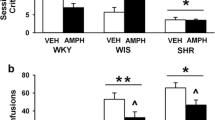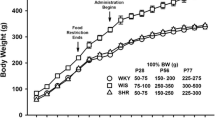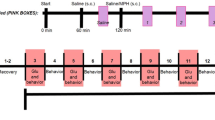Abstract
Rationale
Methylphenidate is a psychostimulant given for extended periods of time as a treatment of attention-deficit/hyperactivity disorder (ADHD). The long-term effects of the drug are not yet known, and it is speculated that repeated exposure may produce drug dependence.
Objective
To investigate the effects of repeated methylphenidate treatment on methylphenidate self-administration and reinstatement in the most validated animal model of ADHD, the spontaneously hypertensive rat (SHR), and Wistar rat, strain representing the “normal” heterogeneous population.
Methods
Rats were administered intraperitoneally with saline or methylphenidate (2 mg/kg) for 14 days, prior to experiments. Thereafter, responses for intravenous methylphenidate under the fixed ratio (FR1 and FR3) and progressive ratio (PR) schedules were assessed. Extinction experiments followed, as well as tests to determine the ability of intraperitoneal administration of methylphenidate (2 and 5 mg/kg) to reinstate extinguished drug-seeking behaviors in rats.
Results
Previous exposure to methylphenidate enhanced methylphenidate self-administration in Wistar rats but not in SHR (FR3). Methylphenidate pretreatment reduced responding for methylphenidate in SHR but did not affect self-administration behaviors of Wistar rats (PR). Methylphenidate pre-exposure robustly reinstated drug-seeking behaviors in Wistar rats, but not in SHR.
Conclusion
The contrasting effects of repeated methylphenidate treatment in methylphenidate self-administration and reinstatement in Wistar and SHR, and the increased susceptibility of the Wistar rat strain to the reinforcing effects of methylphenidate indicate that “normal” individuals are more likely to develop psychological dependence to the drug and experience relapse. Meanwhile, the clinical use of methylphenidate may not produce drug dependence or relapse in ADHD patients.




Similar content being viewed by others
References
Augustyniak PN, Kourrich S, Rezazadeh JS, Arvanitogiannis A (2006) Differential behavioral and neurochemical effects of cocaine after early exposure to methylphenidate in an animal model of attention deficit hyperactivity disorder. Behav Brain Res 167:379–382
Botly LC, Burton CL, Rizos Z, Fletcher PJ (2008) Characterization of methylphenidate self-administration and reinstatement in the rat. Psychopharmacology 199:55–66
Cailhol S, Mormede P (1999) Strain and sex differences in the locomotor response and behavioral sensitization to cocaine in hyperactive rats. Brain Res 842:200–205
Dafny N, Yang PB (2006) The role of age, genotype, sex, and route of acute and chronic administration of methylphenidate: a review of its locomotor effects. Brain Res Bull 68:393–405
dela Peña IC, Ahn HS, Choi JY, Shin CY, Ryu JH, Cheong JH (2010) Reinforcing effects of methamphetamine in an animal model of attention-deficit/hyperactivity disorder—the spontaneously hypertensive rat. Behav Brain Funct 6:72
dela Peña IC, Ahn HS, Choi JY, Shin CY, Ryu JH, Cheong JH (2011a) Methylphenidate self-administration and conditioned place preference in an animal model of attention deficit hyperactivity disorder—the spontaneously hypertensive rat. Behav Pharmacol 22:31–39
dela Peña IC, Ahn HS, Shin CY, Cheong JH (2011b) Neuroadaptations involved in long-term exposure to ADHD pharmacotherapies: alterations that support dependence liability of these medications? Biomol Ther 19:9–20
Epstein DH, Preston KL, Stewart J, Shaham Y (2006) Toward a model of drug relapse: an assessment of the validity of the reinstatement procedure. Psychopharmacology (Berl) 189:1–16
Feltenstein MW, See RE (2008) The neurocircuitry of addiction: an overview. Br J Pharmacol 154(2):261–274
Gerasimov MR, Franceschi M, Volkow ND, Gifford A, Gatley SJ, Marsteller D, Molina PE, Dewey SL (2000) Comparison between intraperitoneal and oral methylphenidate administration: microdialysis and locomotor activity study. J Pharmacol Exp Ther 295:51–57
Gordon SM, Tulak F, Troncale J (2004) Prevalence and characteristics of adolescent patients with co-occurring ADHD and substance dependence. J Addict Dis 23(4):31–40
Heal DJ, Cheetham SC, Smith SL (2009) The neuropharmacology of ADHD drugs in vivo: insights on efficacy and safety. Neuropharmacology 57:608–618
Horger BA, Shelton K, Schenk S (1990) Preexposure sensitizes rats to the rewarding effects of cocaine. Pharmacol Biochem Behav 37:707–711
Kollins SH (2008) ADHD, Substance use disorders, and psychostimulant treatment: current literature and treatment guidelines. J Atten Disord 12:115–125
Kollins SH, MacDonald EK, Rush CR (2001) Assessing the abuse potential of methylphenidate in nonhuman and human subjects: review. Pharmacol Biochem Behav 68:611–627
Lorrain DS, Arnold GM, Vezina P (2000) Previous exposure to amphetamine increases incentive to obtain the drug: long-lasting effects revealed by the progressive ratio schedule. Behav Brain Res 107:9–19
Marco EM, Adriani W, Ruocco LA, Canese R, Sadile AG, Laviola G (2011) Neurobehavioral adaptations to methylphenidate: the issue of early adolescent exposure. Neurosci Biobehav Rev 35:1722–1739
Mendrek A, Blaha CD, Phillips AG (1998) Pre-exposure of rats to amphetamine sensitized self-administration of this drug under a progressive ratio schedule. Psychopharmacology 135:416–422
Meririnne E, Kankaanpaa A, Seppala T (2001) Rewarding properties of methylphenidate: sensitization by prior exposure to the drug and effects of dopamine D1- and D2-receptor antagonists. J Pharmacol Exp Ther 298:539–550
Okamoto K, Aoki K (1963) Development of a strain of spontaneously hypertensive rats. Jpn Circ J 27:282–293
Piazza PV, Deminiere JM, LeMOal M, Simon H (1990) Stress- and pharmacologically-induced behavioral sensitization increases vulnerability to acquisition of amphetamine self-administration. Brain Res 514:22–66
Post RM, Weiss SR, Pert A (1988) Cocaine-induced behavioral sensitization and kindling: implications for the emergence of psychopathology and seizures. Ann NY Acad Sci 537:292–308
Richardson NR, Roberts DC (1996) Progressive ratio schedules in drug self-administration studies in rats: a method to evaluate reinforcing efficacy. J Neurosci Methods 66:1–11
Robinson TE, Berridge KC (1993) The neural basis of drug craving: an incentive-sensitization theory of addiction. Brain Res Rev 18:247–291
Russell VA (2005) The spontaneously hypertensive rat as an animal model of attention deficit hyperactivity disorder. In: Gozal D, Molfese D (eds) Attention deficit hyperactivity disorder: from genes to patient, 1st edn. Humana Press, New Jersey, p 81
Russell VA, de Villiers AS, Sagvolden T, Lamm MC, Taljaard JJ (1995) Altered dopaminergic function in the prefrontal cortex, nucleus accumbens and caudate putamen of an animal model of attention-deficit hyperactivity disorder—the spontaneously hypertensive rat. Brain Res 676:343–351
Russell VA, de Villiers AS, Sagvolden T, Lamm MC, Taljaard JJ (2000) Methylphenidate affects striatal dopamine differently in an animal model for attention deficit/hyperactivity disorder—the spontaneously hypertensive rat. Brain Res Bull 53:187–192
Russell VA, Sagvolden T, Johansen EB (2005) Animal models of attention-deficit hyperactivity disorder. Behav Brain Funct 1:9
Sagvolden T (2000) Behavioral validation of the spontaneously hypertensive rat (SHR) as an animal model of attention-deficit/hyperactivity disorder (AD/HD). Neurosci Biobehav Rev 24:31–39
Sagvolden T, Metzger MA, Schiørbeck HK, Rugland AL, Spinnangr I, Sagvolden G (1992) The spontaneously hypertensive rat (SHR) as an animal model of childhood hyperactivity (ADHD): changed reactivity to reinforcers and to psychomotor stimulants. Behav Neural Biol 58:103–112
Sagvolden T, Russell VA, Aase H, Johansen EB, Farshbaf M (2005) Rodent models of attention-deficit/hyperactivity disorder. Biol Psychiatry 57:1239–1247
Schenk S, Partridge B (1999) Cocaine-seeking produced by experimenter-administered drug injections: dose–effect relationships in rats. Psychopharmacology (Berl) 147:285–290
Segal DS, Kuczenski R (1987) Individual differences in responsiveness to single and repeated amphetamine administration: behavioral characteristics and neurochemical correlates. J Pharmacol Exp Ther 242:917–926
Smith GP, Schneider LH (1988) Relationships between mesolimbic dopamine function and eating behavior. Ann NY Acad Sci 537:254–261
Suto N, Austin JD, Tanabe LM, Kramer MK, Wright DA, Vezina P (2002) Previous exposure to VTA amphetamine enhances cocaine self-administration under a progressive ratio schedule in a D1 dopamine receptor dependent manner. Neuropsychopharmacology 27:970–979
Van der Kooij MA, Glennon JC (2007) Animal models concerning the role of dopamine in attention-deficit hyperactivity disorder. Neurosci Biobehav Rev 31:597–618
Vendruscolo LF, Izidio GS, Takahashi RN (2009) Drug reinforcement in a rat model of attention deficit/hyperactivity disorder—the spontaneously hypertensive rat (SHR). Curr Drug Abuse Rev 2:177–183
Volkow ND, Insel TR (2003) What are the long-term effects of methylphenidate treatment? Biol Psychiatry 54:1307–1309
Wilens TE, Kwon A, Tanguay S, Chase R, Moore H, Faraone SV, Biederman J (2005) Characteristics of adults with attention deficit hyperactivity disorder plus substance use disorder: the role of psychiatric comorbidity. Am J Addict 14(4):319–327
Wilens TE, Adler LA, Adams J, Sgambati S, Rotrosen J, Sawtelle R, Utzinger L, Fusillo S (2008) Misuse and diversion of stimulants prescribed for ADHD: a systematic review of the literature. J Am Acad Child Adolesc Psychiatry 47:21–31
Winger G, Woods JH (1985) Comparison of fixed-ration and progressive-ratio schedules of maintenance of stimulant drug-reinforced responding. Drug Alcohol Dep 15:123–130
Yang PB, Behrang A, Swann A, Nachum D (2003) Strain differences in the behavioral responses of male rats to chronically administered methylphenidate. Brain Res 971:139–152
Yang PB, Cuellar DO, Swann AC, Dafny N (2011) Age and genetic strain differences in response to chronic methylphenidate administration. Behav Brain Res 218:206–217
Yano M, Steiner H (2007) Methylphenidate and cocaine: the same effects on gene regulation. Trends Pharmacol Sci 28:588–596
Zhang XY, Kosten TA (2007) Previous exposure to cocaine enhances cocaine self-administration in an alpha 1-adrenergic receptor dependent manner. Neuropsychopharmacology 32:638–645
Acknowledgements
This research is supported by funds from the National Research Foundation of Korea, Korea Food and Drug Administration (1182–602) and Sahmyook University. The authors have no conflicts of interest to declare.
Author information
Authors and Affiliations
Corresponding author
Rights and permissions
About this article
Cite this article
dela Peña, I., Yoon, S.Y., Lee, J.C. et al. Methylphenidate treatment in the spontaneously hypertensive rat: influence on methylphenidate self-administration and reinstatement in comparison with Wistar rats. Psychopharmacology 221, 217–226 (2012). https://doi.org/10.1007/s00213-011-2564-1
Received:
Accepted:
Published:
Issue Date:
DOI: https://doi.org/10.1007/s00213-011-2564-1




